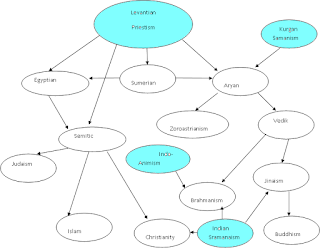As new studies are coming up in the field of population genetics, it is becoming increasingly apparent that, while cultural identity may have been the preserve of males, genetic identity is determined by females. The reason can be very simple. Once colonized the matrilineages stay put even when the patrilineages change.
mtDNA and autosomal analysis:
Considering the fact that in most part of the old world mtDNA is around 50000-40000 years old, it's no wonder that all the later male sweeps in the last 3000-4000 years would hardly leave any genetic imprint in the population except for their Y-chromosomes. One of the visible proof is is the looks (physical shape) of the population that I have already discussed before.
- In the case of Austro-Asiatics in India, even though male lineage Y-chromosome O2a predominates, they look like Indians than SE Asians mainly because of their Indian matrilineages.
- In the case of Finnish, even though male lineage Y-chromosome N1c predominates, they look like Europeans than East Asian mainly because of their European matrilineages.
- In the case of Cameroonians, with a high percentage of Y-chromosome R1b, they look entirely like Africans than Europeans mainly because of their African matrilineages.
But considering the fact that New World fairly recently colonized (around 15000 years), the genetic diversity is very low compared to the old world colonizers who moved there in the last 500 years or so, we may see some strong presence of old world genetic imprint in their autosomal analysis.
But this can never be the case in the old world itself. Here, over time the native matrilineages assert themselves and this could be observed in autosomal analysis.
Ancient Indian Females:
A recent study,
"Reconstructing Indian Population History", rather beautifully illustrates the ancient migrations of Indian matrilineages. It has found two distinct components, Ancient North Indian(ANI) and Ancient South India (ASI). The distinction was made by comparing the markers with Europeans, North Africans and West Asians. ANI is observed among those groups and ASI is restricted only to India. Though in India both ANI and ASI are found mixed in population.
This interesting observation reinforces the fact that all the West Eurasian (North Africa, West Asia and Europe) matrilineages were ultimately derived from an Indian macro haplogroup
mtDNA R. With this study we can even confirm that, one of M lineages, M1, which is found mostly in Mediterranean region was also part of the migration from India.
The researchers make one more observation that Onges, one of the Andaman tribes, are sort of close to ASI. We do know that Onges' Y-chromosome is exclusively Y-Haplogroup D, found mostly in Tibet and Japan but their matrilineage is M31a, found mostly in East India or S E India. This is another case where matrilineage asserting itself (through autosomes) over patrilineage.
The evidences till now appear to support the old model of northern migration route instead of now popular the coastal migration. I have already argued the more the barrier the greater will be the need to migrate for Homo Sapiens before the advent of new technologies. Thus the coastal migration is not a viable hypothesis. Therefore, in my opinion, there were two groups, one in East and the other in North India (that moved from East) that later colonized whole India(or South Asia). The northern group is also responsible for West Eurasian matrilineages though the latter's patrilineages(like R1, E1b1b) might have later swapped the original patrilineags. Even then Y-Haplogroup J (aborigine West Asian), Y-haplogroup I (aborigine European) are sort of closely related to Y-Haplogroup H (aborigine Indian). However, all their matrilineages are descendents of Indian mtDNA R(H, U, JT) and mtDNA M(M1).
Implications:
Genetics does not consider a standard trait as the original trait. It considers various genotypes of a single trait as the pre-existing condition and any single genotype as a clue for
bottlenecks. However, pseudo-science like anthropometry makes the mistake of considering standard look and derived look by admixture. By anthropometry, Indians are measured in terms of standard looks of Australian aborigines, SE Asian (so-called) Negritos, Europeans and Mediterraneans.
But when it comes to autosomes, we can see that diversity creates few standards (because of bottlenecks and isolation) and not popular myth (part of Anthropometry) that the admixture creates diversity (which could be observed only in Y-chromosome haplogroups which themselves change so rapidly to leave any genetic footprint in a population).
Now considering the fact that these so-called standard populations' matrilineages are but a subset of Indian matrilineages, we can argue all those standard looks are subset of Indian diversity. Those are all bottlenecked population.
By population genetics, I would think present day stereotypical Homo Sapiens looks could be attributed to the two main components.
1. African
2. Proto-Asian.
Prot Asian could be further divided into:
1. Indian
2. Bottlenecked Proto-Asian (East Asian)
Whereas the Indian looks could be found in South Asia, the bottlenecked looks derived from Indian looks (or could be from Proto-Asian thro' northern route hypothesis) could be found among:
1. Australian aborigines
2. SE Asian aborigines
3. North African and West Asian
4. European
Sources:
1.
Razib's Gene Expression.
2.
Maju's Leherensuge.
3.
My anthropology discussion forum.
